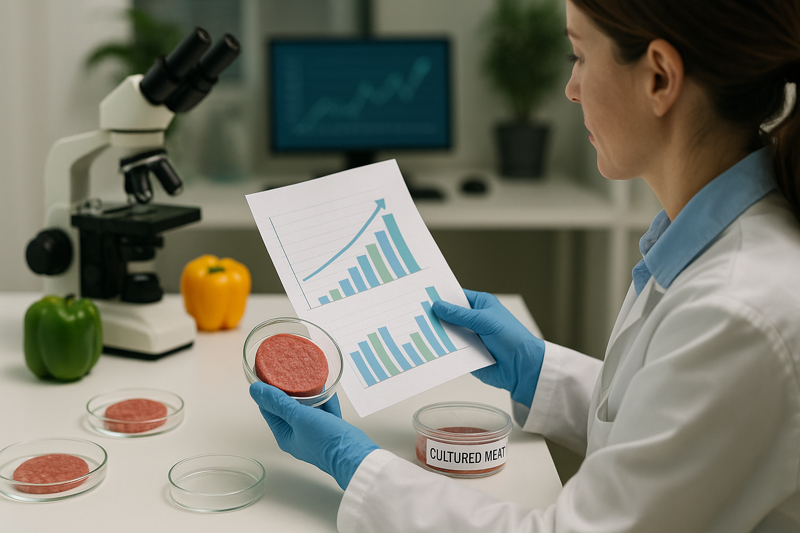AUTHORS:
L. Schenzle, K. Egger, B. Spangl, M. Hussein, A. Ebrahimian Kafshaei, H. Kühnel, F. Ferreira, D. Marques, B. Berchtold, N. Borth, A. Fuchs, H. Pichler: Low-cost food-grade alternatives for serum albumins in FBS-free cell culture media, Nat. Sci. Rep., 2025, 15, 15296 (2025).
L. Schenzle, K. Egger, B. Spangl, M. Hussein, A. Ebrahimian Kafshaei, H. Kühnel, F. Ferreira, D. Marques, B. Berchtold, N. Borth, A. Fuchs, H. Pichler: Low-cost food-grade alternatives for serum albumins in FBS-free cell culture media, Nat. Sci. Rep., 2025, 15, 15296 (2025).
The development of cost-effective, serum-free cell culture media is critical for the advancement of cultivated meat production and the biopharmaceutical industry. Fetal Bovine Serum (FBS) is a major cost driver and poses ethical concerns, while current serum-free alternatives often rely heavily on expensive recombinant serum albumins, creating a production bottleneck. This study explores low-cost, food-grade alternatives to serum albumins for stabilizing serum-free cell culture media.
Focusing on bovine muscle stem cells, we optimized B8/B9 serum-free media formulations. We investigated the potential of methyl cellulose (MC) and racemic alanine (ALA) as alternative stabilizers, known for their non-specific stabilization effects on growth factors like FGF-2. Compared to recombinant human serum albumin (HSA), MC and ALA, individually or in combination, showed comparable or superior stabilization of B8 medium in short- and long-term cultivations. The price for stabilization could be significantly reduced, by a factor of up to 370 compared to B9 medium.
Furthermore, a combination of HSA with MC demonstrated superior stabilization for bovine satellite cells (BSCs), highlighting species-specific requirements in medium optimization. The approach was successfully transferred to other satellite cells (porcine, chicken) and industrially relevant CHO cells, although cell-line specific responses to stabilizers were observed. Notably, HSA-free B8 + MC was the most successful medium for porcine and chicken satellite cells in long-term proliferation. For CHO cells, supplementation with MC, with or without HSA, showed a positive effect on cell viability and EpoFc titers, suggesting potential for stabilizing protein products.
The research demonstrates that food-grade excipients like methyl cellulose and starch from corn can effectively substitute or complement serum albumins in serum-free media. While the exact mechanisms may involve weaker interactions like crowder’s effect or improved cell adhesion due to increased viscosity rather than specific binding, these stabilizers significantly enhance the performance of serum-free media. Dilution strategies in combination with these stabilizers further reduced costs without detrimental effects on cell density or differentiation, achieving up to a 73% overall medium price reduction for certain cell lines.
The findings offer a crucial step towards more affordable and sustainable cell culture, directly addressing the albumin dependency bottleneck in cultivated meat production and potentially lowering production costs for biopharmaceuticals. This research contributes to the efficiency and sustainability of industrial biotechnology processes and supports the 3R concept (Replacement, Reduction, and Refinement) in medical research by providing cost-effective alternatives to animal-derived components. The broad applicability of these stabilizers across various cell lines, including industrially relevant ones, signifies their potential to drive future developments in cellular agriculture and biomanufacturing.
Focusing on bovine muscle stem cells, we optimized B8/B9 serum-free media formulations. We investigated the potential of methyl cellulose (MC) and racemic alanine (ALA) as alternative stabilizers, known for their non-specific stabilization effects on growth factors like FGF-2. Compared to recombinant human serum albumin (HSA), MC and ALA, individually or in combination, showed comparable or superior stabilization of B8 medium in short- and long-term cultivations. The price for stabilization could be significantly reduced, by a factor of up to 370 compared to B9 medium.
Furthermore, a combination of HSA with MC demonstrated superior stabilization for bovine satellite cells (BSCs), highlighting species-specific requirements in medium optimization. The approach was successfully transferred to other satellite cells (porcine, chicken) and industrially relevant CHO cells, although cell-line specific responses to stabilizers were observed. Notably, HSA-free B8 + MC was the most successful medium for porcine and chicken satellite cells in long-term proliferation. For CHO cells, supplementation with MC, with or without HSA, showed a positive effect on cell viability and EpoFc titers, suggesting potential for stabilizing protein products.
The research demonstrates that food-grade excipients like methyl cellulose and starch from corn can effectively substitute or complement serum albumins in serum-free media. While the exact mechanisms may involve weaker interactions like crowder’s effect or improved cell adhesion due to increased viscosity rather than specific binding, these stabilizers significantly enhance the performance of serum-free media. Dilution strategies in combination with these stabilizers further reduced costs without detrimental effects on cell density or differentiation, achieving up to a 73% overall medium price reduction for certain cell lines.
The findings offer a crucial step towards more affordable and sustainable cell culture, directly addressing the albumin dependency bottleneck in cultivated meat production and potentially lowering production costs for biopharmaceuticals. This research contributes to the efficiency and sustainability of industrial biotechnology processes and supports the 3R concept (Replacement, Reduction, and Refinement) in medical research by providing cost-effective alternatives to animal-derived components. The broad applicability of these stabilizers across various cell lines, including industrially relevant ones, signifies their potential to drive future developments in cellular agriculture and biomanufacturing.
